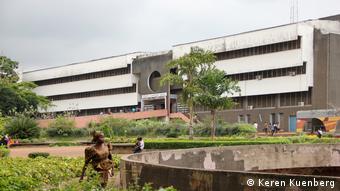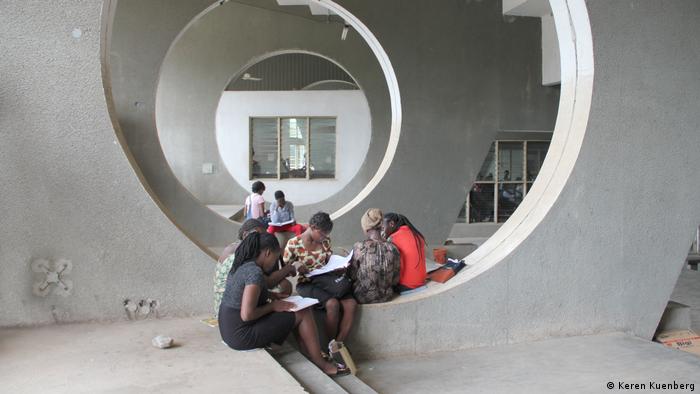That there are buildings of the Bauhaus architects in the United States, in Russia and in Israel, is known. But hardly anyone knows what role was played by the Bauhaus, modern architecture, and pedagogy in Africa.

From the distance you don’t notice the buildings, but when the camera pans in Close-up below, you see that some of the maze of concrete buildings on stilts. The view sweeps under the building through the hilly Park landscape and a gentle breeze moving across the Campus. So anyway, it has experienced the Israeli architect Zvi Efrat, as he went for his documentary about the Ile-Ife Campus, to West Nigeria. The Campus belongs to the University, “Obafemi Awolowo”, named after the famous Prime Minister who led Nigeria to independence.

On the Ile-Ife Campus in Nigeria, there is a lot of shade
From the modern architecture of the complex Zvi is thrilled to Efrat. “It is a passive architecture,” he explains, “an architecture that requires virtually no mechanical systems”. At that time, in 1962, when it began construction, there was hardly any air conditioning, just an understanding of how the building should the climatic conditions will work. “It’s about how You are the air allow to flow through Your building, how to set up shadow courts, and protects against rain.”
An Israeli is building in Nigeria
The Israeli architect Arieh Sharon designed this complex in the West of Nigeria. This happened in the 1960s in the context of an Israeli development program for the Region. Zvi Efrat, architecture Professor, specializing in modern architecture in Israel and Palestine from the 1930s until the 1970s and much about the Israeli architect Arieh Sharon of research.

The Israeli national architect Arieh Sharon
Was formed with Sharon at the “Staatliches Bauhaus” from 1926 to 1929, in the architecture class in Dessau. He then worked in the office of the second Bauhaus Director, the successor of Walter Gropius, Hannes Meyer. The Bauhaus was as an art and design school for the symbiosis of arts and crafts. In his tenure propagated Meyer architecture for the common people and not for luxury needs. With its modern experimental ideas of the Bauhaus, students of language from around the world. The Bauhaus students used to international contacts and settled by other cultures and lifestyles inspire.
As the art and design school was disbanded in 1931 due to the pressure of the national socialists, returned Arieh Sharon to Palestine and became head of the state planning authority. Modern architecture was booming at the time. “Whether in the cities or in the country, whether it was Israeli or Palestinian, everyone is complaining modern Design and modern architecture,” explains Zvi Efrat. “So, Sharon, came from the Bauhaus, it was there quickly to be a Hero.”
The own artistic traditions to discover new
In the 1960s, independence movements in many African States. In the Wake of the decolonization, they turned not only from the architectural style of the old colonial buildings, but also of the curricula in universities and art schools.

For his drawing of Paul Klee’s North African carpet had studied pattern
So in 1966 it was reformed, for example, in Casablanca, the “École des Beaux-Arts”. You want to way to resolve of the French academies of the fine arts, and the division between “high” and “low” art. The own cultural Tradition should serve as a starting point for artistic practice in the modern age. “The Bauhaus was a reference, as regards the synthesis of the arts and craft techniques,” explains the exhibition curator Marion von Osten. “The dissolution of the boundaries between culture and crafts, which was absolutely Central for this school in Casablanca.”
Marion von Osten, along with her colleagues Grant Watson, for the exhibition “Bauhaus imaginista” responsible for the shows in Berlin, the international links of the Bauhaus with other movements in Modern art. There is also still affected, as the craft traditions of other countries, the modern and abstract form language of the Western avant-garde. About the graphic drawings of the painter and Bauhaus master Paul Klee, based on the Patterns of North African carpets.
The Ile-Ife Campus, a Monument of independence
As a sign of the independence of the Campus in Ile Ife. In 1960, the British mandate ended in Nigeria and they wanted to break away from British universities and curricula. A separate representative of the modern University complex, should clarify.

In the exhibition “Bauhaus Imaginista”. In the Background of the Film by Zvi Efrat runs
“Israel became independent in 1948, and had found in its own architectural language with a very heroic building projects,” says Zvi Efrat. For Nigeria, Israel, was a successful model and to dedicated projects for the Israel’s national architects Arie Sharon for the great Campus.
Sharon was excited about the new challenge in a tropical climate, that should keep him busy for many years. The construction of the entire Campus, lasted from 1960 to 1985. Two years traveled to Sharon by Nigeria, to find according to geographic and demographic considerations, a suitable location for the University. As a model for the complex of buildings served the Campus of Ram, Givat Jerusalem from the 1950s. The campus is dominated by a cleverly thought-out architecture and landscape, with open gardens, indoor corridors, courtyards, and covered. It should also be realized in the Nigerian forest landscape of Ife.
The most beautiful Campus in the world
Arieh Sharon put a lot of emphasis on the Material and studied the scientific findings to optimize the function of the building. Everywhere there are spaces in between and shaded roofs. The buildings are graded towards the top growing ever wider. The circumferential corbelled balconies are shaded and protected from the tropical rain.

Teaching space is everywhere, not only in closed classes
Sharon also took into account the local conditions and the local culture. Drawings of the local Yoruba artists to decorate the concrete walls, and bird’s-eye view of the roofs of the buildings seem to be a large pattern abstract West African art.
It is not only the buildings that fascinate Zvi Efrat, but also the way they are used. In Western universities, the buildings are very formal, he says. A classroom is meant for teaching, the auditorium for meetings and outside, you would be in the break. “This Campus is allowed in between the informal use of the many rooms, the inside is neither correct, nor really out there,” he explains. Sometimes it was teaching difficult in the actual classrooms. The air conditioning does not work or there are problems with the electricity. Because the landscape continues under the building, could you teach but also there.
“It works acoustically, and the climate very well,” says Efrat. “Under the building there are always seven degrees less than outside. The Wind ventilated the building. It is so pleasant there.” Many groups could parallel do different things without disturbing and that is very much alive.

The students love their Campus with the shady learning courses
“This is our dream, as architecture should be. I am also a Professor in Israel, and we encourage our students always to build buildings that are more open,” says Efrat. “Building capacity, which is also informally work, but it is never really implemented.”
The students in Ife are very proud of their Campus. “You love him so much that they have made a Song, a hymn, on the architecture of this Campus,” says Zvi Efrat. “And this is also the Name of my film: ‘scenes from the most beautiful Campus in Africa’, as you call him the most beautiful Campus in Africa.”